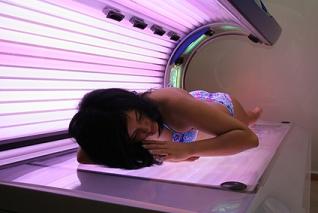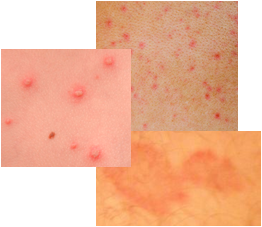Tanning Bed Safety and Skin Cancer
Visit this
PICTURES OF RASHES PAGE
Tanning bed safety, does this exist? There is no real safe way to tan and therefore, skin cancer from tanning beds is always a possibility. Whether you are exposing your skin to the rays of the sun outdoors or indoors in a tanning bed, then you are increasing your risk of skin cancer.
The lamps used in tanning beds do emit ultra violet rays. UV rays can be divided into three separate types: UVA, UVB, and UVC.
UVA rays are categorized as less energetic rays and comprise most of the natural UV content we receive from the sun. With respect to tanning bed safety, the skin is being exposed to these rays in tanning beds. The rays can lead to a host of skin problems such as premature skin aging, sunburns, cell damage, and many other negative effects. The UVA rays intensify the carcinogenic effects of UVB rays and therefore, contribute to skin cancer from tanning beds.

UVB rays are also less energetic rays and comprise about 5 percent of the UV that reaches the earth. UVB rays are present when using tanning beds, but generally, to a much lesser amount that UVA rays. These rays cause similar problems as UVA rays including skin cancer.
Tanning bed safety does not involve being concerned about UVC rays. Although these are more energetic UV rays, they are not emitted by lamps in tanning beds and are not a skin cancer from tanning beds concern.
Safety with tanning beds involves acknowledging that tanning will lead to health and skin problems for many individuals in the future. Use of a tanning bed does not imply that tanning is safe when compared to outdoor tanning. The same risks of skin damage and skin cancer from tanning exist. Some believe that skin cancer from tanning beds is more probable than normal outdoor sun exposure because people are more likely to visit tanning beds year round to maintain a dark skin complexion. Sun exposure is usually seasonal and if averaged over the course of a year, is much less when compared to regular tanning bed use.
Tanning Bed Safety Rules
Using a tanning bed is a personal choice. Individuals will decide for themselves whether a tan is worth the increased risk of developing skin cancer, premature skin aging, and other skin care and health problems. However, for those that choose to tan, then there are certain tanning bed safety rules that can be followed to decrease the risk of skin cancer from tanning beds. Note that following these tanning safety rules may reduce the risk, but tanning still increases the risk of cancer.
- Check the warning labels on tanning lamps used in tanning beds and read them carefully. These labels specify the recommended exposure times to the lamps for different types of skin. They may also indicate how often exposures to the lamps should occur. Do not exceed the recommendations. Replacement bulbs in tanning lamps should be the same as those that came with the original equipment in order to ensure that manufacturer’s recommendations for the tanning bed are valid. As with outdoor UV exposure, individuals with fair skin are at greater risk. Those that have experienced frequent sunburns in the past, especially in their childhood years, are also in a higher risk group for skin cancer from tanning.
- A heat shield such as a clear plastic sheet should be present to prevent heat skin burns that may result from contacting the tanning lamps and to provide protection for the individual in the tanning bed in case of lamp breakage.
- Ensure the staff running the tanning bed salon is knowledgeable and qualified. They should have knowledge on tanning bed safety, risks associated with tanning, and the tanning bed equipment itself. Tanning equipment should meet standard specifications and compliance with radiation emitting device regulations is a must.
- Protect your eyes. Proper eye protection for the type of tanning bed lamps used is required in order to prevent eye problems such as cataracts, photokeratitis, photoconjunctivitis, vision loss, or total blindness.
- Individuals should ensure that the medication they may be on does not increase the likely of sunburns. This is an important and often overlooked tanning beds safety issue.
- Any individual with skin conditions such as rashes, infections, or other skin problems should consult with a physician prior to tanning.
- Avoid consecutive tanning bed sessions. It is best to wait a minimum of 48 hours before using a tanning bed again. However, for best tanning bed safety, it would be a good idea to increase the time interval between tanning sessions. Overall, the less you tan, the better it will be for your overall skin health.
- Tanning bed safety is an important issue for children and teenagers. These age groups, especially under the age of 16, should not use tanning beds! The skin of these individuals is more vulnerable to damage.
- Safety with tanning beds also involves infection control. All contact surfaces in the tanning beds and eyewear should be disinfected between uses.
Tanning bed safety is not an issue with many individuals because they believe that tanning indoors is not as damaging as tanning outdoors. Actually, in some cases, tanning beds can expose the skin to higher amounts of UV than you would normally experience outdoors. Tanning beds will increase the odds of developing skin cancer and other problems and therefore, tanning bed safety should not be taken for granted.
Sunless Tanning
Sunless tanning or sun free tanning is becoming a popular alternative to the traditional sun tanning method of lying out in the sun. It is a great way to not be concerned with tanning bed safety. This is because of the valid concerns of skin cancer and premature aging of the skin with too much sun exposure. The concerns are even greater recently due to ozone related problems in the atmosphere and the fact that suntanning via the traditional way most often leads to dangerous and painful sunburns.
For many, the use of sunless tanners or self-tanning products is a very new area but can be used effectively to get that sun-tanned look without overexposing the skin to the sun. In order to have success in using these products and in order to determine if such products are right for you, then you need to have the appropriate resource of information.
The guide below which is available from healthy-skincare.com discusses sun-free tanning. The book contains information about tanning in general which includes information about those ultraviolet rays that you should be concerned about and how those rays interact with your paricular skin type. Not all skin types react to the sun equally and therefore, this is important information to have on hand. This section is followed by information on sun free tanning and self tanning products and methods to perform tanning without sun exposure. In the guide, you will also learn about the proper method of applying self-tanning lotions. Information is also provided on sunless bronzers, sun less tanning booths, tanning accelerators, tanning pills and vitamin d, tanning tips, and self-tanning product reviews.
All this information is provided below in an easy-to-ready ebook. Purchase the guide on sun-free tanning at the PayPal link below for only $3.99 US. Avoid over exposing your skin to the sun's damaging rays. Avoid the cost and potential damage to your skin caused by tanning booths. Sunless tanning may not be for everyone, but it may be for you, especially if it is done properly and it helps you alleviate your tanning bed safety concerns. This guide will help you make the proper tanning decision.
Sun Free Tanning Guide
More Sun Tanning and Cancer Resources
sun tanning | sun poisoning rash | sunscreen products | tanning beds hives treatment | five signs of skin cancer | skin cancer warning signs | statistics on skin cancer
